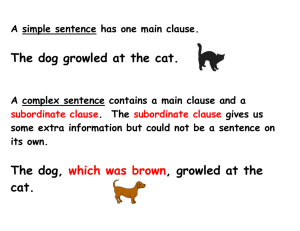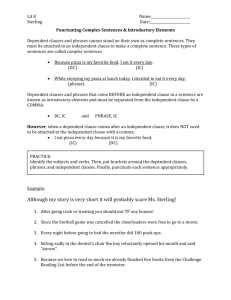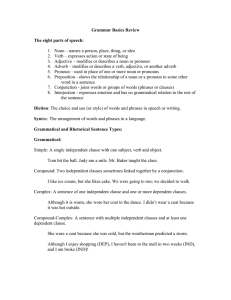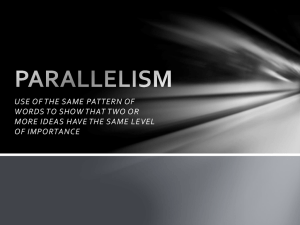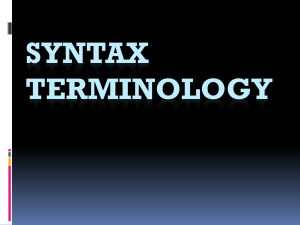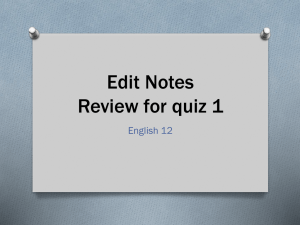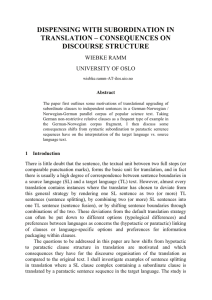SENTENCE PATTERNS
advertisement
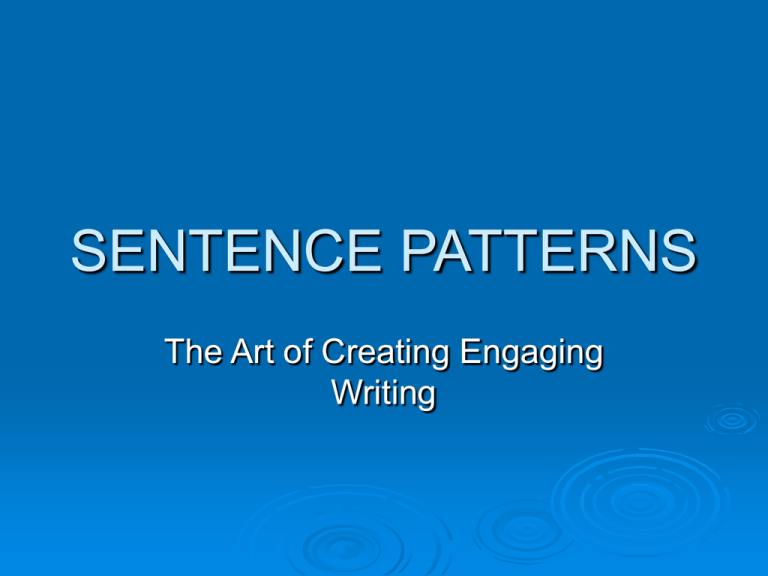
SENTENCE PATTERNS The Art of Creating Engaging Writing Syntax: Definition: the arrangement and grammatical relation of words, phrases, and clauses in sentences and the ordering of words, phrases, clauses and sentences. Syntax helps us to identify a writer’s style. Declarative (strong, active verb): 1. Two problems perplexed the student. 2. Washington offers the tourist two unique spots of interest. 3. Two strange sights startled Steve as he emerged from the cave. Interrogative (question): 1. What two places in the world would you like most to visit? 2. For what two reasons do little boys enjoy stomping in mud puddles? Exclamatory: 1. Two terrible things happened today! 2. I absolutely will not ride that donkey! Imperative (command): 1. Pass the salt, please. 2. Don’t say a word about your actions. Loose Sentence (main clause first; subordinate clause/phrases follow) 1. The long, winding road with its leafless trees suggested solitude and loneliness. 2. The catcher waited patiently for the pitcher to begin. 3. The detective interviewed the witness carefully. Periodic sentence: (subordinate clauses first; main clause closes the sentence). 1. Paralyzed by the neurotic lassitude engendered by meeting one’s past at every turn, around every corner, inside every cupboard, I go aimlessly from room to room. 2. By this rude bridge, their flag unfurled,…and fired the shot heard around the world. 3. After clearing out the furniture, covering the carpet, and removing the pictures, I began painting the large room. Balanced or Parallel Sentence: ( two or more words or constructions must be in the same grammatical form – infinitives, verbs, gerunds, participles, prepositional phrases, clauses, etc. 1. ) To complain of the age we live in, to murmur at the present possessors of power, to lament the past, to conceive extravagant hopes of the future, are the common dispositions of the greatest part of mankind. 2. Teenagers who dance the frug or the jerk are either wild or juvenile delinquents or both. Convoluted Structure: (main clause is split in two; subordinate material is between) 1. Now demons, whatever else they may be, are full of interest. 2. The pizza delivery boy, no matter how late, still expected a hefty tip. 3. The talk-show host, whatever his own opinions are, conducted an excellent interview. Centered Structure (main clause occupies the middle; between subordinate material) 1. Having wanted to walk on the sea like St. Peter, he had taken an involuntary bath, losing his dignity and the better part of his reputation. 2. After digging a large hole, I planted the tree, which was also large and hard to manage. 3. Before he opened the mail, he answered the phone, which had been ringing insistently. Adverbial or Dependent Clause Opener 1. As I shopped for groceries, I found three ways to save money. 2. When I was younger, I liked simple foods. Verb Before Subject or Inverted Word Order: 1. Beside the houses grew two large maple trees. 2. Along the boulevard sped two sleek, fast cars. Appositive (a noun, pronoun, or phrase that renames, identifies, or explain another noun or pronoun next to it): 1. London, the English city on the Thames, offers many tourist attractions. 2. Tuscan combines two cultures: the Spanish/Indian and the American West. Rhetorical Question: 1. Wasn’t the cult of James a revealing symbol, a symbol of an age and society which wanted to dwell like him in some false world of false art and false cultures? From “Henry James and His Cult” by Maxwell Geismar. 2. A good student-body is perhaps the most important factor in a great university. How can you possibly make good wine from poor grapes? Anaphora – (repetition of the same word or group of words at the beginnings of successive sentences) 1. The Lord sitteth above the water floods. The Lord remaineth a King forever. The Lord shall give strength unto his people. The Lord shall give his people the blessing of peace. From Psalm 29 2. It is a luxury, it is a privilege, it is an indulgence for those who are at their ease. From “Letter to a Noble Lord,” 1796 by Edmund Burke Anadiplosis- (Repetition of the last word of one clause at the beginning of the following clause). 1. Labor and care are rewarded with success, success produces confidence, confidence relaxes industry, and negligence ruins the reputation which diligence had raised. 2. The crime was common, common be the pain. Epistrophe: (Repetition of the same word or group of words at the ends of successive clauses) 1. Shylock: I’ll have my bond! Speak not against my bond! I have sworn an oath that I will have my bond! The Merchant of Venice 2. We cannot learn from one another until we stop shouting at one another. From Inaugural Address by Richard Nixon Paradox: (an apparently contradictory statement that nevertheless contains a measure of truth) 1. Art is a form of lying in order to tell the truth. – Pablo Picasso 2. Water, water everywhere but not a drop to drink. Assignment: 1. Analyze your style of writing. What patterns do you use the most? 2. What patterns can you add to make your writing more interesting? Revisit a former piece of writing (informal, mini- essay or critique). Recompose your writing, incorporating four new structures (patterns). Underline the new patterns used.



